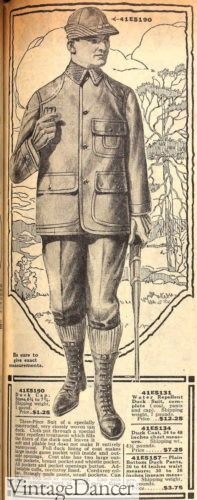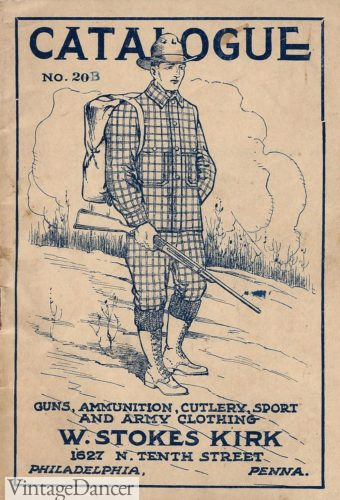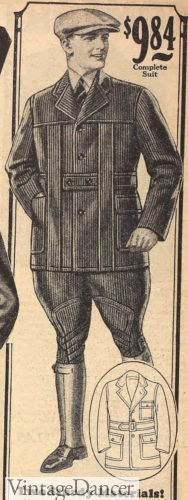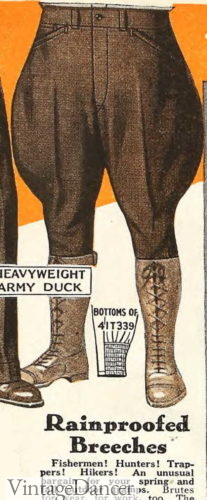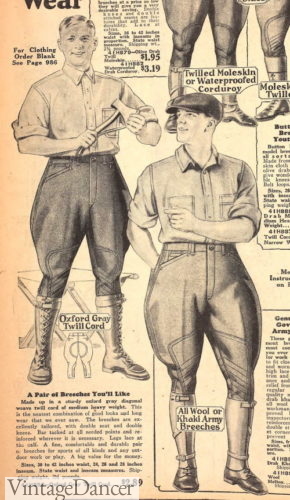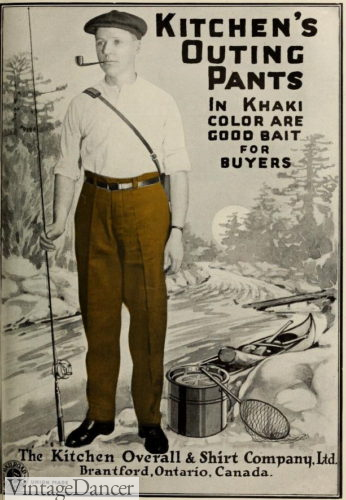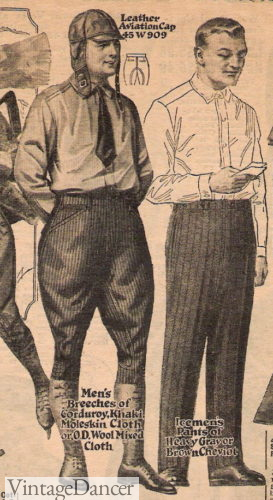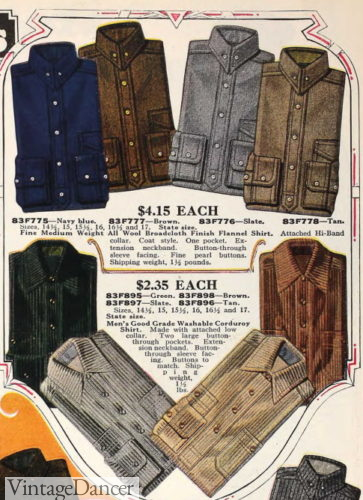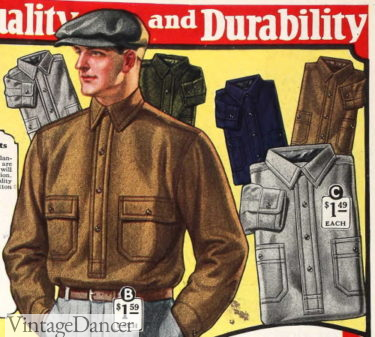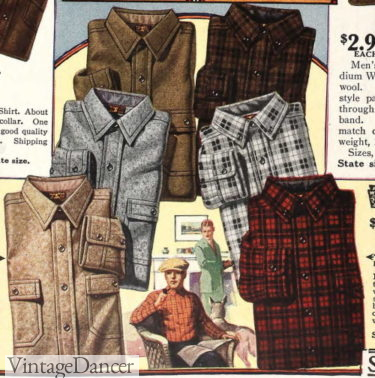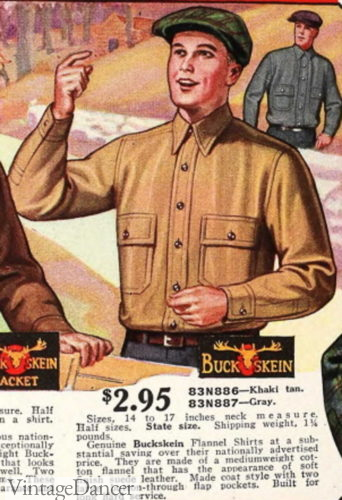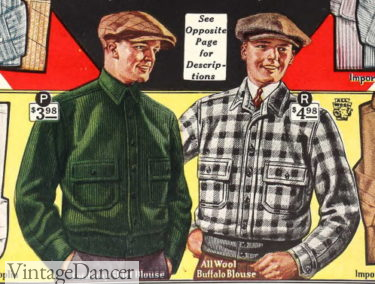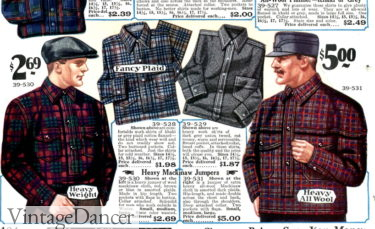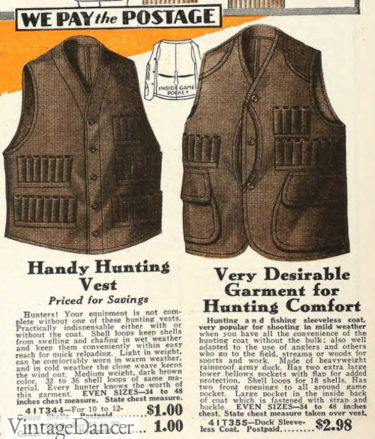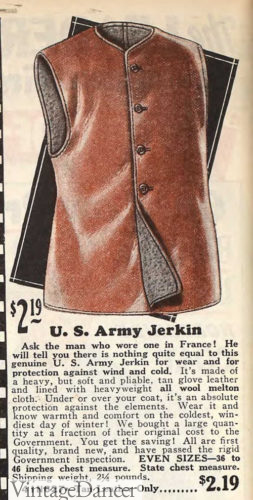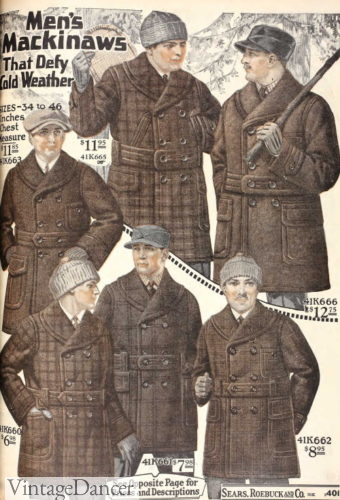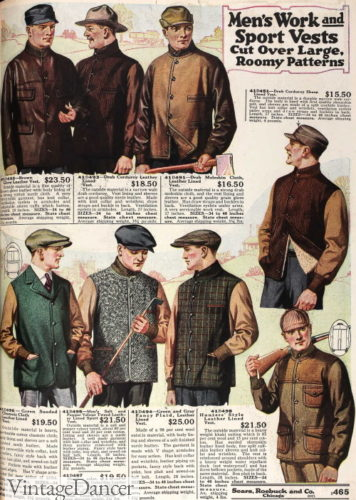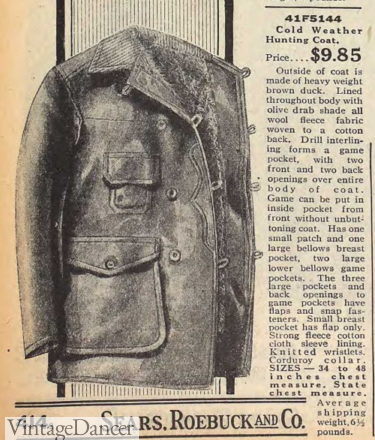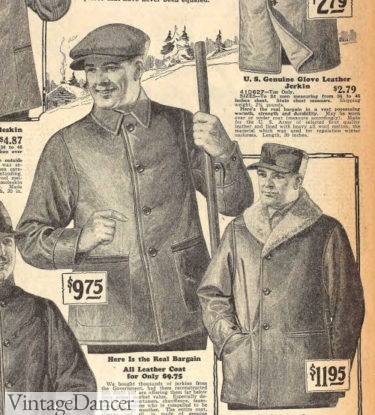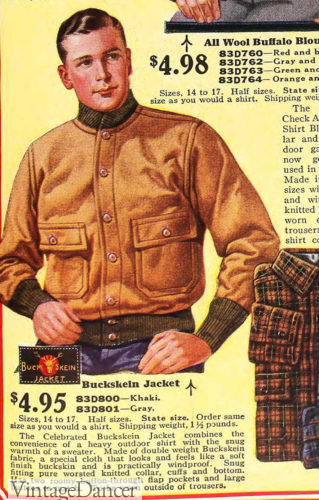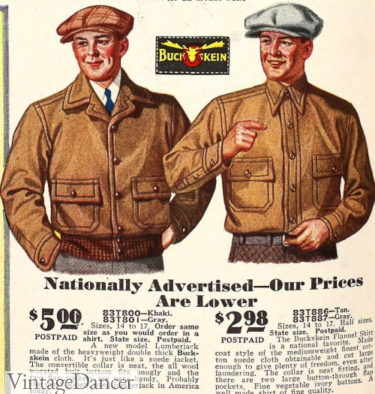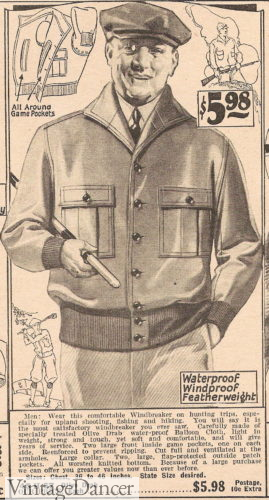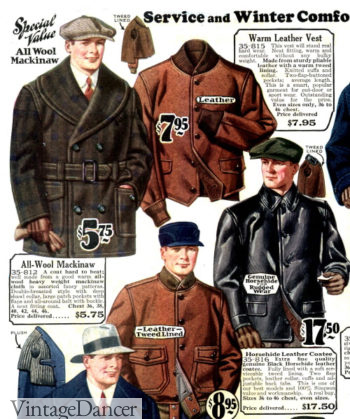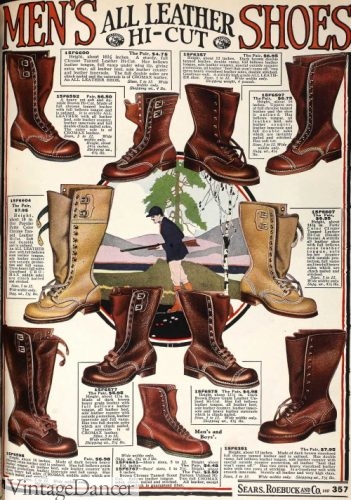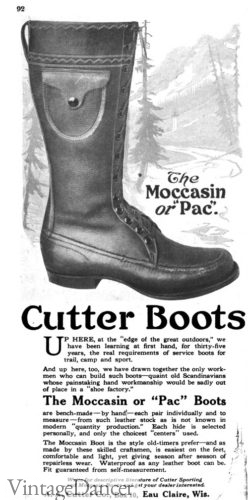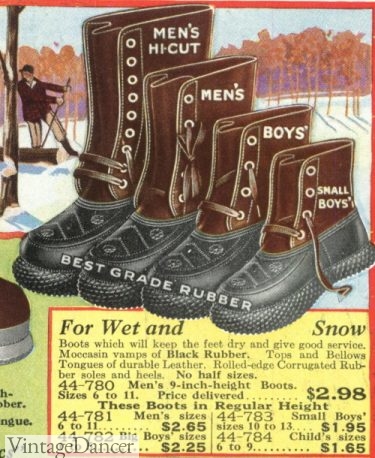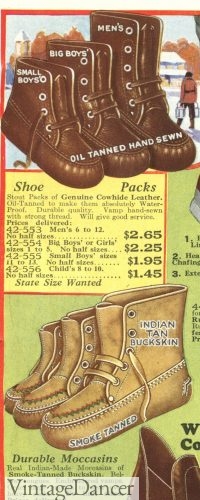1920s men’s outdoor wear for hiking, camping, riding, hunting, shooting, and fishing has become a popular topic recently. It is one I addressed for women with women’s hiking clothing, but now I need to turn to the men’s side.
Unfortunately, there isn’t one good source of information on the topic. I turned to my collection of clothing catalogs and specialty outdoor catalogs to look at what was sold to the outdoorsmen. Many clothes overlap with men’s 1920s workwear so take a look at this article as well.
At the end of the article are good brands to buy vintage sporting goods, clothes, and some additional resources for your own research.
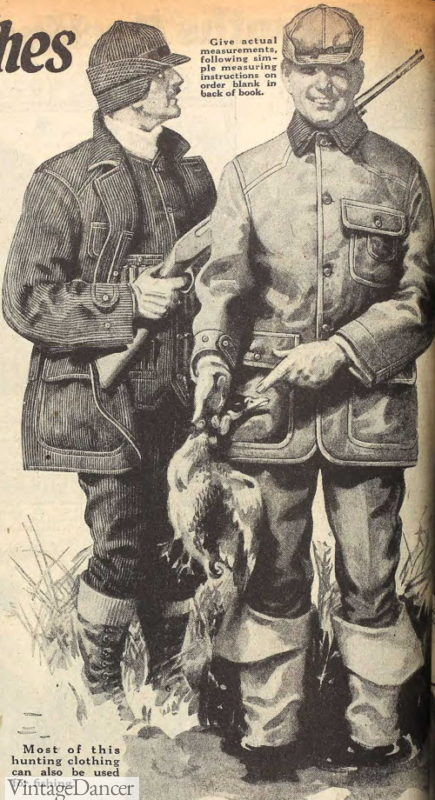
1921 Hunting Clothes for Men – Corduroy and Duck Cloth Sets
1920s Men’s Breeches and Pants
Fabrics for 1920s men’s outdoor clothing were either wool or cotton corduroy in a dark green or dry grass tan. Waterproof cotton duck cloth in khaki tan (like a heavy canvas) was the other popular fabric. Some men wore leather, especially motorcycle riders, aviators, and race car drivers.
- 1921 Hunting Clothes for Men
- 1920 Check Tweed Hunting Outfit
- 1928 Corduroy Suit
Men could wear breeches or long trousers. Breeches were those funny looking, wide hipped and tight knee laced short pants (sometimes mistakenly called jodhpurs or golf knickers). They had extra lining around the seat, thigh, and knee.
Breeches were held up by an optional leather belt, never suspenders.
- 1920 Hunting Breeches
- 1922 Corduroy Sport Breeches Suit
- 1927 Casual, Sport, or Work Breeches
- 1929 Khaki Breeches
Long trousers were less common in the early 1920s but gained acceptance as the decade moved on. They featured a flat front and a tapered leg in the early 20s, and wide leg by the mid 1920s. A cuff was often added.
Trousers were held up by button on suspenders or a belt.
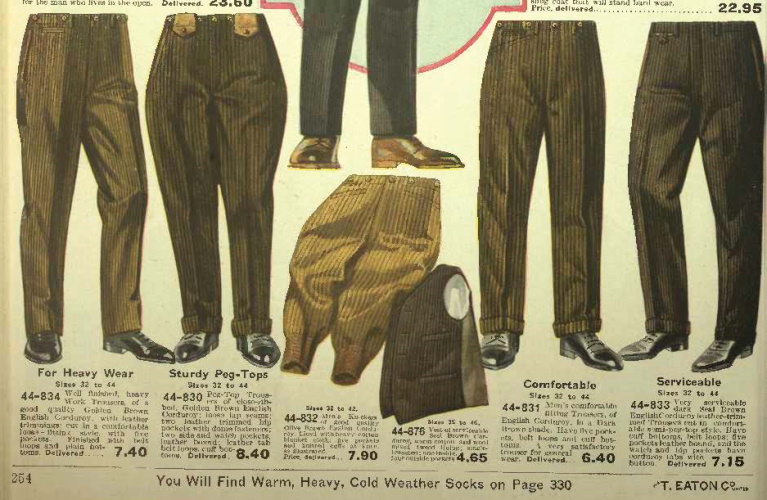
1920 Corduroy Trousers
- 1921 Cotton Khaki Pants
- 1923 Wool Breeches and Pants
Outdoor Shirts
Outdoor shirts were the same as work shirts or casual men’s shirts. Made of heavy flannel, they were thick and heavy with two chest pockets with a button-down flap. Shirt were “coat style,” meaning they pulled on overhead and buttoned down only to the waist, with an additional 10 inches of fabric tucked into trousers.
Shirts could also be made of corduroy, mackinaw wool cloth (very heavy, usually plaid), or a brushed cotton flannel that looked like suede.
Plaid flannel shirts became associated with hunters and outdoor sportsmen towards the end of the decade, especially in buffalo red and black plaid.
- 1921 Corduroy Shirts
- 1926 Flannel Shirts
- 1924 Plaid Flannel Shirts
- 1928 Suede-Feel Cotton Flannel, Called Buckskein
A hybrid between shirt and light jacket emerged in the late 1920s. Sometimes called “blouses” they are called shirt-jacs today. They buttoned down the front, ending at the waist. Either they had a notch collar like a jacket, or a standard shirt collar, but they were made of shirting materials. While normally worn untucked, they could be tucked in as well. More on these can be found under ‘Jackets.’
- 1926 Corduroy Shirt and Plaid Shirt Jacket
- 1928 Flannel Shirts
Hunting Vests
A matching corduroy or wool vest was often sold in a set of outdoor sporting clothes. The more durable option was the old Army Jerkin with leather outer and inner wool cloth lining.
Hunting and fishing vests may have had extra pockets, bullet holders, and pouches for holding supplies.
- 1920 Men’s Wool Vests and Bullet Holders
- 1928 Army Jerkin Vest
Sweaters and Knitwear
Instead of vests, a warm knit pullover sweater, sweater vest, or cardigan could have been worn as a layering piece. These often had loud patterns like checks, Fair Isle, Aztec, and geometric patterns. Solid red or bright blue were both good choices for hunters.
Learn more about men’s 1920s sweaters and knitwear.
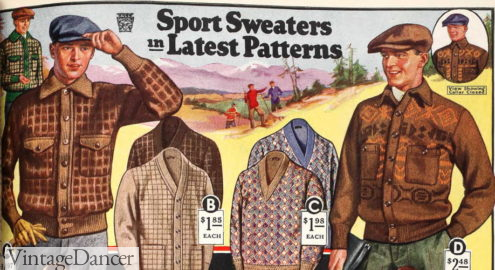
1926 Knitwear
Coats and Jackets
Heavy coats and jackets were part of most hunters’ and sportsmen’s collections. These were made of heavy mackinaw wool (plaid or plain colors), suede, leather, moleskin, duck cloth, or corduroy. They were often lined in shearling or wool pile. Some in the early years were looked like leather vests with cloth sleeves (an old military style).
- 1922 Mackinaw Coats
- 1920 Coats and Jackets
- 1921 Hunting Coat of Duck Cloth
- 1925 Leather Hunting Jacket
Lighter jackets were good for warm seasons. These were called “blouses,” “lumberjackets” or “windbreakers.” Most had two large pockets placed on the torso or mid chest, with flaps and buttons. The collars were ribbed knit, convertible fold outs or sharkfin shaped. They buttoned up the front and had a ribbed waistband and cuffs (cuffs would also be open with a button tab). Read more about 1920s men’s coats and jackets.
- 1925 Men’s Buckskein Jacket
- 1926 Lumberjack Shirt – Jacket and Shirt
- 1928 Windbreaker Jacket
- 1928 Men’s Work or Casual Heavy Jackets
Boots and Puttees
A good hiking boot was critical. Tall lace-up boots were the most common, featuring thick leather soles. They laced up and over the breeches, almost to the knee. The alternative was a short boot with a leather legging called a puttee (also called gaiters today). It protected the legs like a boot, but was more flexible to wear at the ankle.
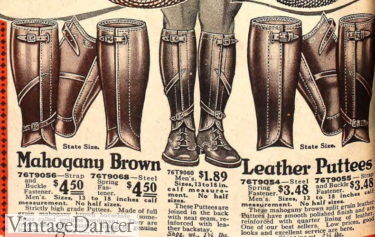
1924 puttees
Some men wore soft leather moccasin boots for both hunting, snow-sports, and fishing. They were very warm as well as quiet to walk in. Likewise, the rubber bottom boot (Duck Boots) were the best are keeping out mud. Full rubber boots were for fisherman.
Learn more on the men’s 1920s work clothes article or the men’s winter boots articles.
- 1921 Men’s Work Boots
- 1921 Hunter’s Moc Boot
- 1928 Duck Boots
- 1928 Oiled Leather Shoepac and Buckskin Moccasin
Hats
Soft cloth caps and hats were the best for outdoor wear. A simple flat cap was casual and sporty, perfect for any sport. A brimmed crusher hat or ventilator hat was similar to a bucket hat but with the back side folded up. Tweed bucket hats were dressier styles for gentlemen.
The duck hat had fold down earflaps that tied in the front when not folded, popular with hunters. So was the baseball cap style, with one single brim and optional earflaps.
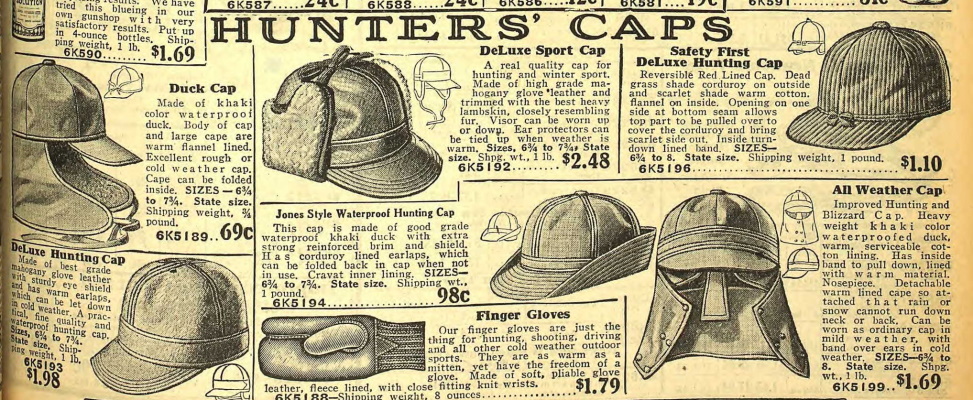
1927 Sport Hats
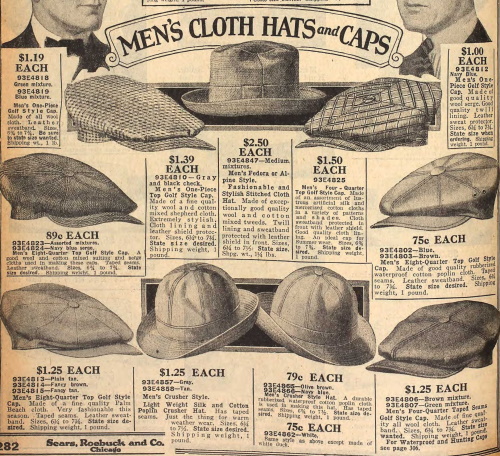
1921 Cloth Caps and Hats
Men’s Clothing For Sale
Reproduction or inspired classic hunting and outdoor clothes are limited to a few brands. They don’t often label an inspired by date on the clothes, so you will have to do your best to get the right look for the 1920s.
- Filson – Heavy duty outdoor workwear boots, jackets, pants, fishing, hunting clothes
- Bronson Mfg / MAYA ($$) – Unique military reproduction and 1940s-1950s style jeans and trousers.
- L.L.Bean ($$) – Still make some of their original “Heritage” shirts, jackets and boots
- Walker and Hawkes – Classic British shooting breeks, jackets, hats, socks
- Schott NYC ($$$) – Famous for their leather jackets, 1920s-1960s styles. Also shirts, pants, boots.
- Duluth Trading Co ($$) – Thick outdoorsman’s plaids and Henley tees with a great product guarantee.
- Runabout Goods ($$$) – Excellent no-frills hiking and outdoors shirts.
- Bryceland’s ($$$) – Plaid and Western style with a more modern/slim silhouette.
- Mister Freedom ($$$) – Themes ranging from military surplus to sailor wear to gentleman’s shirting.
- Standard and Strange ($$$) – Retailer for various brands. Milsurp, sportsman, outdoorsman, and other rugged workwear types.
- Oldfield Clothing – Reproduction knitwear and clothing from the 1920s/30s/40s
- Logsdonandco – Reproduction camping clothes, boots and accessories for the 20th century
- Standard and Strange ($$$) – Vintage style clothing for the worker/rustic
- Clutch Cafe (UK – $$$) – A variety of vintage inspired military, sporty, and casual pants and shorts.
- Kai D Utility – For the urban rustic everyday style. Made in New York City.
- Wolverine’s Thousand Mile Boot is a great vintage profile boot
- Frye Boots ($$) – Tall and short boots can also be found on eBay.
- Red Wing Boots ($$$) – Famous historic work and outdoor boots.
- Huckberry ($$-$$$) – Mixed brand rugged workwear, casual outdoor, farmwear.
More brand lists:
Research
- 1916 Abercrombie & Fitch Catalog – Men’s and Women’s hunting, hiking and outdoor supplies and clothing.
- Covers of Outdoor Magazines at USU – Google search for any of these magazines to find digital or physical copies.
- Field and Stream Magazine archives
- Clothing Catalogs – Browse through the men’s clothing section or hunting/camping supplies
Debbie Sessions has been teaching fashion history and helping people dress for vintage themed events since 2009. She has turned a hobby into VintageDancer.com with hundreds of well researched articles and hand picked links to vintage inspired clothing online. She aims to make dressing accurately (or not) an affordable option for all. Oh, and she dances too.
